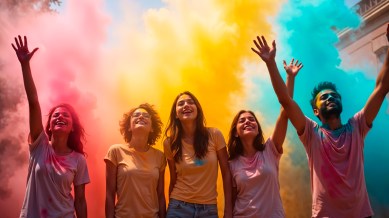Phoolon Ki Holi to Holla Mohalla: 10 unique ways India celebrates the festival of colours
From devotional gatherings to grand processions, each region adds its unique touch to Holi celebrations.

Holi, the festival of colours, is one of the most lively celebrations in India. But it’s more than just smearing gulal and tossing water balloons. Different regions of the country infuse their own traditions, weaving together mythology, local customs, and cultural influences. From Vrindavan’s flower-filled Holi to Punjab’s high-energy martial arts displays, each region has something special to offer. Whether it’s the rhythmic beats of dhol in Bihar or the artistic charm of Shantiniketan, Holi in India is truly magical. Let’s explore ten fascinating ways Holi is celebrated in the country.
Dola Jatra in Odisha and Doul Yatra in Assam
In Odisha, Dola Jatra or Dola Purnima, celebrated on Holi, is a tribute to Lord Jagannath, also known as Dolagobinda. Devotees step out, applying gulal and rejoicing in faith and unity. In Assam, the Satras of Barpeta mark the occasion with grand processions, where an image of Lord Krishna is carried around the holy fire seven times. Across both states, the festival is a beautiful mix of devotion, colour, and tradition, honouring the supreme protector, Lord Jagannath.
Holla Mohalla in Punjab
In Punjab, Holi is not just about the colours—it’s about strength and valour. Celebrated mainly in Anandpur Sahib, Holla Mohalla was started by Guru Gobind Singh as a festival to showcase the martial skills of Sikh warriors. Instead of throwing colours, participants display sword fighting, horse riding, archery, and mock battles. The festival also includes spiritual kirtans, langars (community meals), and energetic processions, making it one of the most unique Holi celebrations in India.
Phaguwa in Bihar
Also known as Phagwah or Phalgunotsava, Bihar’s Holi is a high-spirited celebration marking the arrival of spring and the harvest season. The festivities begin with Holika Dahan on Phalgun Purnima, symbolising the triumph of good over evil. The next day, Dhulendi, is filled with colour play, folk songs, and energetic dances, creating a truly unforgettable experience.
Lathmar Holi in Uttar Pradesh
In the twin towns of Barsana and Nandgaon—believed to be Radha and Krishna’s hometowns—Holi takes on a playful twist with Lathmar Holi. According to legend, Lord Krishna once teased Radha and her friends, prompting them to chase him away with sticks (lathis). Today, women re-enact this by playfully “attacking” men with sticks, while gulal fills the air, making for an exhilarating and colourful spectacle.
Yaosang in Manipur
In Manipur, Holi merges with the six-day Yaosang Festival, which blends Hindu and indigenous traditions. It begins with the burning of a thatched hut, similar to Holika Dahan, followed by children collecting donations, much like trick-or-treating. The highlight is Thabal Chongba, a traditional moonlit dance where men and women form circles and dance to folk songs. The festival concludes with a colour play, making it a truly distinctive celebration.
Ukuli in Kerala
Among Kerala’s Kudumbi and Konkani communities, Holi is known as Ukuli or Manjal Kuli. Instead of synthetic colours, yellow turmeric water is used for a more eco-friendly celebration. The festival also includes temple processions, folk songs, and ritualistic prayers. Though not as widespread in Kerala, it remains a cherished tradition among these communities.
Rang Panchami in Maharashtra and Madhya Pradesh
Celebrated five days after Holi, Rang Panchami marks the festival’s grand conclusion, especially in the temples of Mathura and Vrindavan. More than just playing with colours, it symbolises the triumph over negative human traits like ego, selfishness, and laziness. The festival is also believed to purify the environment, bringing renewal and positivity. Rooted in Hindu philosophy, it signifies the balance between action and detachment, reinforcing the idea that one should rise above worldly distractions and embrace joy and spiritual growth.
Basanta Utsav in Shantiniketan, West Bengal
Inspired by Rabindranath Tagore, Basanta Utsav (Spring Festival) in Shantiniketan, which coincides with Holi, is a cultural extravaganza. Students dressed in colourful clothes, put on a grand artistic performance for visitors. This includes graceful dances set to the melodies of Rabindranath Tagore’s songs. The event culminates with a joyful exchange of colours. Over the years, Basantotsava has become an integral part of Bengali heritage, drawing countless tourists eager to experience its unique charm.
Phoolon Ki Holi in Vrindavan
Vrindavan, known for its deep association with Lord Krishna, celebrates a special version of Holi using only flowers. At the Banke Bihari Temple, priests and devotees shower petals instead of colours, creating a breath-taking spectacle. The event is accompanied by bhajans, devotional dances, and prayers, making it peaceful and spiritual experience.
Royal Holi in Udaipur
Holi in Udaipur is a royal affair. On Holika Dahan, countless bonfires light up the city, with the grandest celebration taking place at Jagdish Temple. The festivities mirror Rajasthan’s regal heritage, with processions, folk performances, and traditional rituals, making Holi here an unforgettable experience.